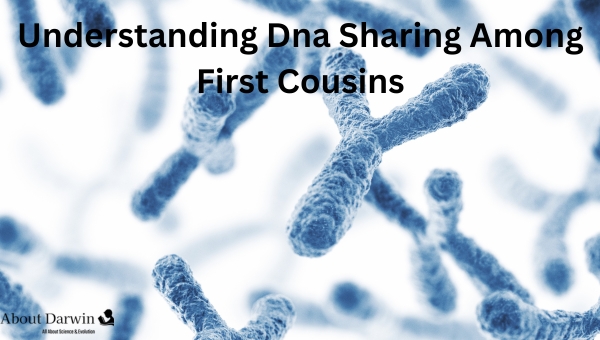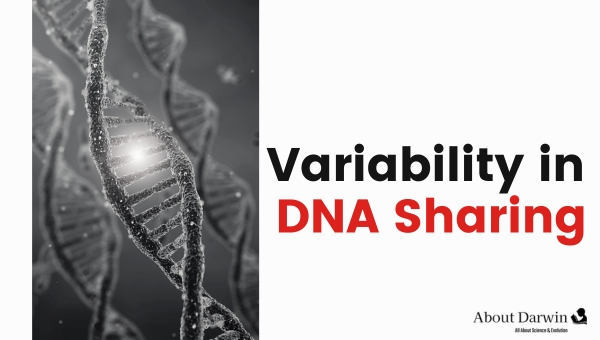Physical Address
304 North Cardinal St.
Dorchester Center, MA 02124
Exploring the intricate web of familial relationships reveals fascinating insights into our genetic connections. First cousins typically share about 12.5% of their DNA, while half-first cousins share around 6.25%.
These percentages highlight the complexity of genetic inheritance and the unique patterns that emerge within families. As you unravel these genetic ties, you may discover unexpected connections that deepen your understanding of family heritage and identity.
The world of DNA sharing is not just about numbers; it’s a journey into the essence of what binds us together.
Contents
DNA sharing among cousins is a fascinating area of genetic genealogy that helps us understand familial relationships through shared genetic material. The amount of DNA shared between cousins can vary significantly due to the random nature of genetic inheritance.

Generally, first cousins share a substantial portion of their DNA, which is critical for genealogical research and understanding family connections. This shared DNA can be quantified in centimorgans (cM), a unit that measures genetic linkage.
Below are key points regarding DNA sharing among various cousin relationships:
These percentages and ranges is vital for those engaged in genealogical research or utilizing DNA testing services to trace their ancestry and familial connections.
First cousins typically share an average of 12.5% of their DNA, which equates to approximately 866 centimorgans (cM), with a range from 396 to 1397 cM. This genetic sharing occurs due to the inheritance patterns of DNA from each parent, where each cousin receives half of their genetic material from their respective parents, who are siblings.
The amount of DNA shared between first cousins is comparable to that shared between great-grandparents and great-grandchildren or between half-aunts/uncles and half-nieces/nephews. Interestingly, first cousins can share as little as 6.25% (around 433 cM) in some cases, particularly when considering relationships like first cousins once removed or half first cousins.
However, it is not possible for first cousins to share 25% of their DNA; such a percentage would indicate a closer relationship, such as half-siblings or grandparents.
Moreover, all first cousins will share some DNA, as the likelihood of not sharing any DNA only arises with more distant relatives beyond the second cousin level.
Half first cousins share a unique genetic relationship, stemming from one common grandparent instead of two, as seen in full first cousins. On average, half first cousins share approximately 6.25% of their DNA, which translates to about 460 centiMorgans (cMs).
This percentage can vary, with typical ranges from 2% to 11.5% depending on individual genetic inheritance patterns. The distinction between half first cousins and full first cousins is significant; full first cousins share about 12.5% of their DNA due to having both grandparents in common.
In practical terms, this means that while half first cousins may have some shared traits or health predispositions, their genetic connection is less pronounced than that of full first cousins.
These relationships is crucial for genealogical research and can help clarify family histories, especially in cases involving blended families or unknown parentage.
The differences in DNA sharing between full cousins and half cousins is essential for grasping familial relationships. DNA inheritance is a complex process, where individuals inherit genetic material from their parents, which is then passed down through generations.
Full cousins share a greater percentage of DNA compared to half cousins due to their common ancestry. This distinction not only highlights the genetic connections but also the implications for genealogical research and understanding family trees.
The following table summarizes the average percentage of DNA shared between full and half cousins, as well as other related familial relationships:
| Relationship | Average % DNA Shared | Range |
|---|---|---|
| Full Cousin | 12.5% | 7.31% – 13.8% |
| Half Cousin | 6.25% | Approximately 3% – 9% |
| Full Sibling | 50% | Varies by specific relationship |
| Half Sibling | 25% | Varies by specific relationship |
| Grandparent/Grandchild | 25% | Varies by specific relationship |
| Aunt/Uncle/Niece/Nephew | 25% | Varies by specific relationship |
Full cousins share about 12.5% of their DNA due to having both grandparents in common, while half cousins share approximately 6.25%, as they only share one grandparent.
This genetic sharing can significantly impact genealogical research, providing insights into familial connections and ancestral heritage.
The concept of DNA sharing among distant cousins is rooted in genetic genealogy, which examines how much DNA individuals inherit from common ancestors. This sharing is quantified in centiMorgans (cM), a unit that measures genetic linkage.
The amount of DNA shared can help determine familial relationships, particularly for distant cousins.
First cousins once removed (1C1R) represent a unique familial relationship that occurs when one cousin is from a different generation than the other. The genetic implications of this relationship can be complex, particularly when it comes to DNA sharing.
Below are key points regarding the DNA sharing characteristics between first cousins once removed.
These aspects can help clarify the nature of relationships within family trees and the genetic connections that define them.
First cousins twice removed (1C2R) represent a more distant familial connection, occurring when one cousin is two generations apart from the other.
This relationship can be intriguing in terms of genetic sharing, as it provides insight into how DNA is passed down through generations.
Below are key points regarding the DNA sharing characteristics between first cousins twice removed.
These aspects can help clarify the nature of relationships within family trees and the genetic connections that define them.
You might be surprised to know that while it’s possible for first cousins to share about 25% of their DNA, due to the random nature of genetic inheritance, they can also potentially share no DNA at all.

This variability in DNA sharing is a fascinating aspect of genetics and one that challenges our traditional understanding of familial connections.
So, before you make any assumptions about your genetic relationship with your first cousin, it’s important to consider these possibilities and understand the science behind them.
While it’s quite a fascinating concept, it’s rare but entirely possible for first cousins to share as much as 25% of their DNA. This situation is often due to genetic anomalies and significant DNA overlaps, which can lead to relationship confusion.
You see, inheritance patterns aren’t always predictable. Just like how you wouldn’t necessarily inherit 50% of each of your parents’ traits, cousins don’t always share the expected 12.5% DNA.
These variations enhance gene pool diversity and are integral to human evolution. But remember, such high percentages in shared DNA among first cousins might hint at a closer biological relationship than initially thought or even incestuous unions in the family history. So yes, understanding these nuances is crucial!
Believe it or not, there’s a chance that two people, known to each other as first cousins, might not carry any common genetic markers at all. This is due to the unpredictable nature of inheritance patterns and rare genetic anomalies.
Here are four reasons why this could happen:
Understanding these complexities gives you greater freedom when exploring your ancestry.
When you’re trying to determine cousin relationships, DNA testing with multiple family members can be a handy tool. It not only provides scientific evidence of your familial connections.
It also complements and enhances your utilization of basic genealogy strategies. Combining these two methods can create a more comprehensive and accurate picture of your family tree.
DNA testing with multiple family members can deepen your understanding of your shared genetic history, unearthing secrets and connections that you’ve never dreamed of.
By comparing your DNA segments with those of your relatives, you can create a detailed chromosome map that will give you invaluable insights into your ancestral tracing.
Thus, familial DNA testing expands knowledge boundaries while offering freedom in our quest for self-understanding.
Having understood the significance of DNA testing among multiple family members, let’s delve into how you can utilize basic genealogy strategies to enrich your understanding of shared DNA among first cousins.
When it comes to ancestry exploration, genealogy basics are paramount. They offer insights into genetic inheritance patterns and guide the construction of your family tree.
| Genealogy Basics | Relevance |
|---|---|
| Ancestry Exploration | Understands past familial connections |
| Family Tree Construction | Visualizes lineage and relationships |
| Genetic Inheritance Patterns | Predicts possible DNA sharing |
| DNA Testing Methodologies | Validates theoretical predictions |
Remember, being armed with knowledge is freedom in itself! Mastering these core concepts doesn’t just deepen your grasp on shared genetics; it opens doors to a fascinating journey through time, unveiling your unique identity woven by countless generations before you.
Also Read: What Are Double First Cousins? Discover The Relationship
Your DNA plays a crucial role in your health, potentially leading to genetic disorders. DNA sequencing can reveal your genetic predisposition to diseases, aiding personalized medicine and guiding genetic counseling sessions for preventative measures.
In forensic science, your DNA can be crucial for crime solving. Forensic identification often relies on DNA profiling or genetic fingerprinting from evidence collection to create a unique ‘genetic fingerprint’ which could identify you.
In DNA replication, DNA helicase unzips the double strand forming replication forks. Replication mechanisms then enable base pairing, creating two identical DNA strands. This chromosome duplication impacts how much DNA you’d share with relatives.
You must consider privacy risks and informed consent when sharing or testing DNA. Direct-to-consumer testing can expose family secrets, possibly leading to genetic discrimination. Always understand the implications before proceeding.
DNA mutations occur when errors happen during DNA replication. These mutation types increase genetic variability and evolutionary impact. Mutation rates vary, with mutational hotspots seeing more changes, influencing shared DNA traits among relatives.
The genetic connections between relatives reveals intriguing insights into our ancestry. First cousins typically share about 12.5% of their DNA, reflecting their direct familial link, while half-first cousins share approximately 6.25% due to a more distant relationship.
Additionally, first cousins once removed also exhibit a shared DNA percentage of around 6.25%, as they are separated by one generation.
These percentages not only inform us about genetic similarities but also enhance our appreciation for the complex tapestry of familial ties that shape our identities and heritage.